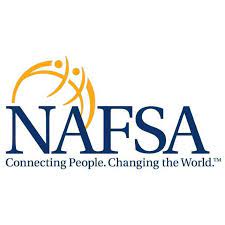NAFSA: Association of International Educators
 | |
| Formation | 1948 |
| Membership | • Jeff Riedinger • Diana Carlin • Nancy Kidd • LaNitra Berger • Shinsaeng Ko • Ahmad Ezzeddine • Stephen Appiah-Padi • Bonnie Bissonette • Susana Carrillo • • Lee A. Feinstein • Heather Barclay Hamir • Fernando León-García • Francisco Marmolejo • Ann Mason • Francis J. Ricciardone • Lawrence Schovanec • Muddassir Siddiqi • Julie Sinclair • Sara Thursto • Esther D. Brimmer |
| The world's largest nonprofit association dedicated to international education and exchange. | |
NAFSA: Association of International Educators is the world's largest nonprofit association dedicated to international education and exchange.
Based in the United States, NAFSA provide programs, products, services, and physical and virtual meeting spaces for the worldwide community of international educators. [1]
Strategic area
The selection of and access to foreign students is a highly strategic area, with significant interests to the deep state. Foreign students coming to the United States are often future leaders in all sectors of society, and a study stay an important method to spread US influence.
This is reflected in NAFSA's board membership, which contains senior State Department diplomats and others with connections to deep state think tanks and education units, and to corporate interests.
For decades, the CIA has been known to actively scout, woo and recruit foreign students.[2] Studying in the United States normally takes several years, which gives and extended window of opportunity for recruitment safely on home ground.
Even if active recruitment does not happen, the agency can create future ties and obligations that can be exploited at a later date. This comes in addition to the students self-selecting by studying there, by already having a positive image of the country, and continuing it in their future careers.
History of NAFSA
NAFSA was founded in 1947, in the beginning of the Cold War as the National Association of Foreign Student Advisers to help promote the professional development of American college and university officials responsible for assisting and advising the 25,000 foreign students who had come to study in the United States after World War II. Members included academic institutions, government agencies and private organizations. The association's scope soon expanded to include admissions personnel, English-language specialists, and the community volunteers who played an important role in helping foreign students become acclimated to American college communities. To reflect this growing and increasingly diverse membership, in 1964 the association changed its name to the National Association for Foreign Student Affairs.
By 1990, as the number of foreign students in the United States approached the 400,000 mark, there were 6,400 NAFSA members on 1,800 campuses, and increasing numbers of U.S. students were studying abroad. To reflect the now well-established role of NAFSA members in all aspects of international education and exchange, the name of the association was changed once more. In May 1990 the membership formally renamed the organization NAFSA: Association of International Educators, retaining the acronym to reflect NAFSA's proud past and broad name recognition.[3]
Related Quotations
| Page | Quote | Author | Date |
|---|---|---|---|
| Victor Marchetti | “To the Clandestine Services the universities represented fertile territory for recruiting espionage agents. Most large American colleges enrolled substantial numbers of foreign students, and many of these, especially those from the Third World, were (and are) destined to hold high positions in their home countries in a relatively few years. They were much easier to recruit at American schools — when they might have a need for money, where they could be easily compromised, and where foreign security services could not interfere — than they would be when they returned home. To spot and evaluate these students, the Clandestine Services maintained a contractual relationship with key professors on numerous campuses. When a professor had picked out a likely candidate, he notified his contact at the CIA and, on occasion, participated in the actual recruitment attempt. Some professors performed these services without being on a formal retainer. Others actively participated in agency covert operations by serving as "cut-outs," or intermediaries, and even by carrying out secret missions during foreign journeys.” | Victor Marchetti | 1974 |
| Victor Marchetti | “Helms asked his staff to find out just how many university personnel were under secret contract to the CIA. After a few days of investigation, senior CIA officers reported back that they could not find the answer. Helms immediately ordered a full study of the situation, and after more than a month of searching records all over the agency, a report was handed in to Helms listing hundreds of professors and administrators on over a hundred campuses. But the staff officers who compiled the report knew that their work was incomplete . Within weeks, another campus connection was exposed in the press. The contact was not on the list that had been compiled for the Director.” | Victor Marchetti | 1974 |
Known member
1 of the 21 of the members already have pages here:
| Member | Description |
|---|---|
| Nelson Cunningham | Well-connected Kissinger associate |